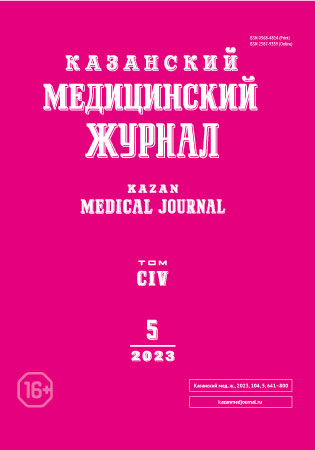The role of plant adaptogen in the correction of parameters of the hemostasis system during emotional-immobilization stress in the experiment
- Authors: Obraztsova L.A.1, Bondarchuk Y.A.1, Shakhmatov I.I.1, Manaeva I.N.1, Lisina S.V.1
-
Affiliations:
- Altai State Medical University
- Issue: Vol 104, No 5 (2023)
- Pages: 709-715
- Section: Experimental medicine
- Submitted: 13.02.2023
- Accepted: 05.07.2023
- Published: 28.09.2023
- URL: https://kazanmedjournal.ru/kazanmedj/article/view/217671
- DOI: https://doi.org/10.17816/KMJ217671
- ID: 217671
Cite item
Abstract
Background. Maladaptive changes on the part of various organs and systems, in particular on the part of the hemostasis system, are manifested in extreme forms of physical inactivity, one of which is immobilization stress. If the organism is also subjected to psycho-emotional effects at the same time, then the combined effect of stressors is accompanied by an increase in maladaptive disorders.
Aim. To establish the influence of emotional-immobilization stress on the hemostasis system, as well as the possibility of correcting changes by taking a course of eleutherococcus.
Material and methods. The experiment was conducted on male rats, which were divided into four groups: the first group (n=14) — control, the second group (n=14) — animals treated with eleutherococcus for 30 days, the third group (n=14) — rats, subjected to a single 3-hour “water-immersion dipping”, the fourth group (n=14) — animals that took eleutherococcus for 30 days before the “water-immersion dipping”. The state of the hemostasis system was assessed in all experimental groups. Statistical processing of the results was performed using the Statistica 10.0 package (Statsoft, USA). Significance of differences was assessed using the nonparametric Mann–Whitney test and Student's t-test.
Results. A single immobilization effect was accompanied by hypercoagulable changes, which characterized by shortening of the silicone (p=0.001) and kaolin (p=0.002) time. Completion of the 30-day adaptogen intake followed by emotional immobilization stress was accompanied by an increase in silicone (p=0.001), kaolin (p=0.021), prothrombin (p=0.021) and thrombin (p=0.006) time, which indicated hypocoagulation changes.
Conclusion. The immobilization effect is characterized by hypercoagulability against the background of a decrease in the anticoagulant and fibrinolytic activity of the blood plasma; the course intake of eleutherococcus prior to immobilization is accompanied by hypocoagulant changes and an increase in the anticoagulant activity of the blood plasma.
Keywords
Full Text
About the authors
Lolita A. Obraztsova
Altai State Medical University
Author for correspondence.
Email: mob1977@mail.ru
ORCID iD: 0000-0001-5283-4996
student
Russian Federation, Barnaul, RussiaYulia A. Bondarchuk
Altai State Medical University
Email: bondarchuk2606@yandex.ru
ORCID iD: 0000-0002-2661-5965
M.D., Cand. Sci. (Med.), Assoc. Prof., Depart. of Normal Physiology
Russian Federation, Barnaul, RussiaIgor I. Shakhmatov
Altai State Medical University
Email: iish59@yandex.ru
ORCID iD: 0000-0002-0979-8560
M.D., D. Sci. (Med.), Prof., Head of Depart., Depart. of Normal Physiology
Russian Federation, Barnaul, RussiaIrina N. Manaeva
Altai State Medical University
Email: krinitsina.irina@mail.ru
ORCID iD: 0000-0003-0554-6945
Assistant, Depart. of Normal Physiology
Russian Federation, Barnaul, RussiaSvetlana V. Lisina
Altai State Medical University
Email: sunrisemsv@gmail.com
ORCID iD: 0000-0002-8944-7380
M.D., Cand. Sci. (Med.), Assoc. Prof., Depart. of Normal Physiology
Russian Federation, Barnaul, RussiaReferences
- Salekhov SA, Maksimiuk NN, Salekhova MP. Influence of physical inactivity on development of somatopsychic disorders. Vestnik NovGU. 2016;(6):124–126. (In Russ.)
- Begrambekova YuL, Orlova YA. Health benefits of aerobic exercise: known mechanisms and research potential. Cardiovascular Therapy and Prevention. 2021;20(5):2878. (In Russ.) doi: 10.15829/1728-8800-2021-2878.
- Golovskoy BV, Berg MD, Bulatova IA, Voronova EI, Khovaeva YB. Muscular system in maintaining health and preventing chronic non-infectious diseases. Perm Medical Journal. 2021;38(1):72–86. (In Russ.) doi: 10.17816/pmj38172-86.
- Zaripova RI, Andrianov VV, Yafarova GG, Gainutdinov KhL, Khabibrakhmanov II, Zefirov TL. Influence of hypokinezia of varying duration on the nitric oxide productions dynamics in rat’s heart, spinal cord and liver. Russian journal of physiology. 2014;(8):926–935. (In Russ.)
- Krupatkin AI. Blood flow oscillations — new diagnostic language in microvascular research. Regional blood circulation and microcirculation. 2014;13(1):83–99. (In Russ.) doi: 10.24884/1682-6655-2014-13-1-83-99.
- Ivanov AN, Grechikhin AA, Norkin IA, Puchinyan DM. Methods of endothelial dysfunction diagnosis. Regional blood circulation and microcirculation. 2014;13(4):4–11. (In Russ.) doi: 10.24884/1682-6655-2014-13-4-4-11.
- Mamayev AN. Prakticheskaya gemostaziologiya. Rukovodstvo dlya vrachey. (Practical hemostasiology. A guide for physicians.) M.: Prakticheskaya meditsina; 2014. 233 р. (In Russ.)
- Morozova VT, Avdeeva NA. Koagulologicheskie sindromy. Laboratornaya diagnostika. (Coagulation syndromes. Laboratory diagnostics.) M.: Izd-vo RMAPO; 2014. 149 p. (In Russ.)
- Sel'e G. Ocherki ob adaptatsionnom sindrome. (Essays on the adaptation syndrome.) M.: Meditsina; 1960. 254 p. (In Russ.)
- Batrak GE, Kudrin AN. Dozirovanie lekarstvennykh sredstv eksperimental'nym zhivotnym. (Dosing of drugs to experimental animals.) M.: Meditsina; 1979. 168 p. (In Russ.)
- Baluda VP, Barkagan ZS, Gol'dberg ED, Kuznik BI, Lakin KP. Laboratornye metody issledovaniya sistemy gemostaza. (Laboratory methods for studying the hemostasis system.) Tomsk: Iz-vo Tomskogo universiteta; 1980. 310 p. (In Russ.)
- Momot AP. Patologiya gemostaza: printsipy i algoritmy kliniko-laboratornoy diagnostiki. (Pathology of hemostasis: principles and algorithms of clinical and laboratory diagnostics.) SPb.: FormaT; 2006. 208 p. (In Russ.)
- Momot AP, Tsyvkina LP, Taranenko IA, Mamaev AN, Serdyuk GV, Shakhmatov II, Lydina IV, Grigor'eva EV., Belozerov DE, Nikitina DA, Strozenko LA, Petrekova OV, Bespalova OV, Lomaev IS. Sovremennye metody raspoznavaniya sostoyaniya tromboticheskoy gotovnosti. Monografiya. (Modern methods of recognizing the state of thrombotic readiness. Monograph.) A.P. Momot, editor. M.: Znanie-M; 2022. 146 p. (In Russ.)
Supplementary files








